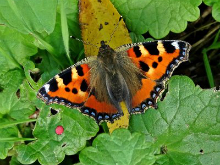
Widespread and common


Distribution and Status
The Small Tortoiseshell is a common and widespread resident although there has been an alarming reduction in numbers since the mid 1990s. It was thought that a parasitic fly Sturmia bella was largely responsible for the decline. However, numbers picked up spectacularly in 2013 and 2014 although the last few years have seen abundance drop again still indicating a significant long-term downward trend. Application of herbicides and pesticides in the countryside is a contributory factor including the use of neonicotinoids on field margins where wild flowers and larval foodplants can absorb chemicals adversely impacting insects including butterflies (Gilburn et al.). Malcolm Hull's observations of hibernating adults in his shed suggest there could be a 'lost generation' (second brood) - see below for link to his article.
Habitat Requirements
Almost anywhere from gardens to mountains but it is most abundant where nettles abound
Larval Foodplants
Common Nettle Urtica dioica, Small Nettle Urtica urens
Adult Food Sources
Buddleia Buddleja davidii, Creeping Thistle Cirsium arvense, Hemp Agrimony Eupatorium cannabinum
Behaviour/Observation notes
It usually spends mornings feeding and basking so this is probably the best time of day to get close-up views and take photographs. Males set up territories in the afternoon on nettle beds and mating occurs often very late in the day, which is partly the reason why few photographs of mating pairs are captured

Life History
The Small Tortoiseshell usually produces two broods a year. Overwintering adults often appear on the first warm days of the year, even early as January and continue flying until early May. The first new generation emerges in around June and although some of these adults go into hibernation others will produce another brood in August. Populations are subject to immigration and emigration so numbers can vary enormously. Females lay eggs on nettles in mostly open and sheltered situations, and prefer young fresh shoots of the plant. Larvae construct a chain of webs at the top of the nettles from which they feed. When fully grown they disperse to pupate attached to a leaf or stem
Further information
Photo gallery
Branch Annual Report (2022)
The Lost Generation - Malcolm Hull
UK distribution map
Full list of larval hostplants (Nymphalidae)
Stevenage butterflies - additional notes